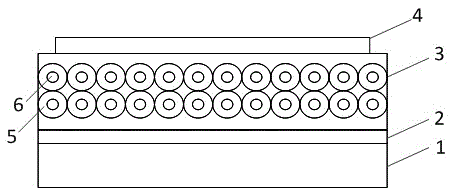Perovskite-type solar cell and preparation method
A solar cell and perovskite-type technology, applied in circuits, photovoltaic power generation, electrical components, etc., can solve the problems of low photoelectric conversion efficiency, achieve the effects of improving photoelectric conversion efficiency, increasing contact area, and improving absorption efficiency
- Summary
- Abstract
- Description
- Claims
- Application Information
AI Technical Summary
Problems solved by technology
Method used
Image
Examples
Embodiment 1
[0035] This embodiment includes the following steps:
[0036] (1) Preparation of TiO 2 dense electron transport layer
[0037] First, clean the clear FTO glass. The FTO glass with a size of 2.0×2.0cm was first cleaned with detergent to remove surface oil and particulate pollutants, then ultrasonically cleaned with deionized water, acetone and alcohol for 15 minutes, and then dried with nitrogen to remove residual organic matter on the surface of the FTO glass .
[0038] Then TiO was prepared by radio frequency magnetron sputtering (RF) 2Dense electron transport layer, the FTO glass substrate is placed in the sputtering chamber, and the pressure of the sputtering chamber is pumped to 2.5×10 -4 Pa, the argon gas with a purity of 99.9% was introduced, and after gas washing twice, the sputtering pressure was controlled at 0.1Pa, and the sputtering power was 100W. Dense TiO obtained on FTO 2 electron transport layer.
[0039] (2) Preparation of composite light-absorbing laye...
Embodiment 2
[0048] This embodiment includes the following steps:
[0049] (1) Preparation of TiO 2 dense electron transport layer
[0050] First, clean the transparent ITO glass. The ITO glass with a size of 3.0×3.0cm was first cleaned with detergent to remove surface oil and particulate pollutants, then ultrasonically cleaned with deionized water, acetone and alcohol for 15 minutes, and then dried with nitrogen to remove residual organic matter on the surface of the ITO glass .
[0051] Then TiO was prepared by radio frequency magnetron sputtering (RF) 2 Dense electron transport layer, the ITO glass substrate is placed in the sputtering chamber, and the pressure of the sputtering chamber is pumped to 2.5×10 -4 Pa, the argon gas with a purity of 99.9% was introduced, and after gas washing twice, the sputtering pressure was controlled at 0.1Pa, and the sputtering power was 100W. Dense TiO obtained on ITO 2 electron transport layer.
[0052] (2) Preparation of composite light-absorbi...
Embodiment 3
[0061] This embodiment includes the following steps:
[0062] (1) Preparation of ZnO dense electron transport layer
[0063] First, clean the transparent ITO glass. The ITO glass with a size of 3.0×3.0cm was first cleaned with detergent to remove surface oil and particulate pollutants, then ultrasonically cleaned with deionized water, acetone and alcohol for 15 minutes, and then dried with nitrogen to remove residual organic matter on the surface of the ITO glass .
[0064] Then the ZnO dense electron transport layer was prepared by radio frequency magnetron sputtering (RF), the ITO glass substrate was placed in the sputtering chamber, and the pressure of the sputtering chamber was pumped to 2.5×10 -4 Pa, the argon gas with a purity of 99.9% was introduced, and after two washes, the sputtering pressure was controlled at 0.1Pa, and the sputtering power was 500W. A dense ZnO electron transport layer was obtained on ITO.
[0065] (2) Preparation of composite light-absorbing l...
PUM
 Login to View More
Login to View More Abstract
Description
Claims
Application Information
 Login to View More
Login to View More - R&D
- Intellectual Property
- Life Sciences
- Materials
- Tech Scout
- Unparalleled Data Quality
- Higher Quality Content
- 60% Fewer Hallucinations
Browse by: Latest US Patents, China's latest patents, Technical Efficacy Thesaurus, Application Domain, Technology Topic, Popular Technical Reports.
© 2025 PatSnap. All rights reserved.Legal|Privacy policy|Modern Slavery Act Transparency Statement|Sitemap|About US| Contact US: help@patsnap.com

